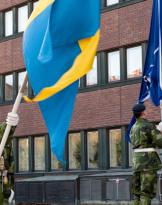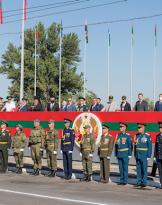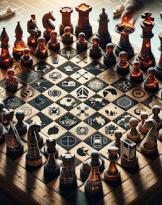There are often conflicting data on different media about the same news. Usually many say one thing and few say the opposite. Whom to believe? Obviously the reader will come to the truth based on his very personal reasoning. However, to reflect deeply and understand becomes increasingly difficult even for the most informed: the complex world of media and information gathering is apparently simplified as extremely diversified.
"Thirty companies dominate the information market, these 144 companies belong to North America, 80 to Europe, 49 to Japan and 27 to the rest of the world. 4 agencies from these three hundred run the 80% of the news flow : the United States Associated Press and United Press International, the British Reuter and the French Press France. Nearly all of the information from the South of the world goes through these big news agencies before reaching our newspapers and our TG "1. The interesting quotation mark, even if dated for a few years, helps to clarify the real flow of information and the data that are provided to the end users of the media.
Journalists who preceded us have left important annotations and articles on how to manipulate certain information and how certain structures tend to influence public opinion through press agencies, sometimes unaware of them. According to Carmine Pecorelli: "The press agencies are the big tap from which the crude oil flows, together with the filter, and journalists draw the raw material from the news, which is provided to the consumer reader in the form of information that has already been purified and refined By controlling the tap, ie determining and directing the flow of raw material, then delaying, filtering or denying the news, means to reduce and censor, to a greater or lesser extent, the right to information.With the choice of news, or the elimination of those censored, is always linked to considerations of a political nature and, in a broader, economic sense "2.
An old saying states that "the whole world is country" and that is why there are strong analogies between country and country. Certain authoritative foreign observers have raised doubts about the US system, which, moreover, tends to rely on and take as a model. According to the American Noam Chomsky, one of the greatest contemporary thinkers: "It's the big newspapers and television chains that make or manipulate the public opinion of eighty percent of the population.There is a way of dealing with news, choosing, limiting and re-launching it that is functional to the elite of power. a pervasive system that can not be shirked in. In the US there are about 1800 newspapers, 11 thousand weekly, 11 thousand radio stations, 200 TV stations, 2500 publishing houses More than fifty percent of all this is controlled by about twenty companies. Their source of survival is advertising: it is not the consent of the public that makes living, but advertising (or particular interests) "3.
 Naturally, to sell more copies or increase the audience, strong emotions are needed, therefore the excellent Paolo Murialdi "There is sensationalism, a trend that, by latent, has become a very common practice, if not common. I understand the needs, I have been a journalist for many years. But all of these big, full-page titles repeated throughout the newspaper are overwhelming. I mean, while there is still a hierarchy of choices on the front page, it is lost inside. Then there is the issue of sources and source control. Is there the second source? We ask it very rare "4.
Naturally, to sell more copies or increase the audience, strong emotions are needed, therefore the excellent Paolo Murialdi "There is sensationalism, a trend that, by latent, has become a very common practice, if not common. I understand the needs, I have been a journalist for many years. But all of these big, full-page titles repeated throughout the newspaper are overwhelming. I mean, while there is still a hierarchy of choices on the front page, it is lost inside. Then there is the issue of sources and source control. Is there the second source? We ask it very rare "4.
If a journalist or a reader bases almost all of his firepower on agency dispatches or official sources - or pseudo-such - the risk of making mistakes increases considerably because an account is the battlefield (even if they give a tunnel effect view) provided by a journalist who readers know and appreciate, another portrays the findings of someone else who the reader does not know or is tied to a trust relationship. But even on the battlefield, you have to be very cautious, because the good friend Giampaolo Cadalanu explains: "In the summer of last year, in Tripoli, my Libyan translator was astonished that I was indignant at the lies of the rebels. It was the transcendental Council's very awkward attempts to use the thirst for news of the international press to convince the public Western public of exaggerated or even non-existent atrocities, or more likely to provide the governments of the West with adequate pretexts to justify military intervention "5.
Let's take a little known historical fact about the Biafra and the divulgation of the news but excellently reported by Goffredo Parise in his book Political wars: "There was a war, done as it could be done. For advertise to his cause and to war in the nations all over the world, Negro Ojukwu, in agreement with a powerful Swiss advertising company, installed a telescrivent in the forest. to this, because something had to be given to the readers of the telescrivent who was writing to newspapers all over the world, and this something had to be sensationally explosive, so little sensational and explosive was the news of a local war among tribes "6.
Often, we have come across real buffalos not to mention real products on specially organized sets and that were not at all in the place they meant.
 Suffice it to say that in the White House there was, under the presidency of Bush Jr., theOffice of Strategic Influence, also called theOffice of lies7. The enormous interests at stake are actually white paper for any kind of initiative, even the most daring and incredible. One among them: the plan designed by the secret services of the Kaiser to acquire control and ownership of some newspapers in our country, such as "il Tempo" and "La Stampa" newspapers, in order to push through an organized neutrality campaign and conveyed by the journalistic headlines acquired. The intent was to push Italy out of the World War8.
Suffice it to say that in the White House there was, under the presidency of Bush Jr., theOffice of Strategic Influence, also called theOffice of lies7. The enormous interests at stake are actually white paper for any kind of initiative, even the most daring and incredible. One among them: the plan designed by the secret services of the Kaiser to acquire control and ownership of some newspapers in our country, such as "il Tempo" and "La Stampa" newspapers, in order to push through an organized neutrality campaign and conveyed by the journalistic headlines acquired. The intent was to push Italy out of the World War8.
Take for example the supposed destruction of Aleppo, when only one area was affected by the fights or the fanciful news of 'the last pediatrician of the same city. Absolutely unrealistic or unlikely data but unfortunately bounced on the media. Not to mention the grip of Sirte ripped off to control Gaddafi. Other news absolutely not adhering to the reality of the facts in its overall picture. Why March 28 Starting With Al Jazeera in the 4 edition: 35 GMT, continuing with Sky New hours 7,19 GMT and ending with Euronews always on the same day there was talk of nothing but the imminent fall of Sirte in the hands of the rebels, all accompanied by videos of the rebels in frantic activity9. Fortunately, an Italian journalist, the great Cristiano Tinazzi of "the Messenger", denied with a video test that as much argued by the cannons of great caliber was not reported10.
During the Libyan crisis, figures on combat deaths have been turned into absolute dizziness. Talking about dead 10.000 in a few days of fighting is something that really knows the war can not fail to realize how wrong the data is.
Mimmo Cndido, an authentic master of war journalism, felt obliged to write in his blog, hosted on "La Stampa" on 26 February 2011: "Si is repeatedly told of 10.000 dead, perhaps even 15.000, of carpet bombing on the crowd, of mass graves right on the beach, and they appeared on the screens of the news fleeting images, which should have represented the merits of the news (the image "documents "and" certifies "the reality) that were transmitted to the voice by the conductor or later, in the newspapers, by the titles in large letters. In almost 40 years of wars told around the world, I have learned to have some caution in receiving news of uncontrollable catastrophe.

Ten thousand deaths are a size that even the Srbreniza slaughterhouse could not give a measurable measure; and carpet bombings on cities are a practice that should not be difficult to find evidence in the testimonies (especially as witnesses, often not accustomed to "living" a war, and often emotionally involved before, even culturally, tend to exaggerate their impact with the drama of the experience they have been forced to undergo). Instead, the testimonies of the first men who had managed to leave Libya were certainly talking of violent clashes, of massacres often perpetrated by black mercenaries, but never referring to these bombings on the crowd of protesters or to violence that would make those figures credible monstrous "11.
But not all victims are the same, because if we take the model Jerzy Popieluszko, Polish priest killed by the Communist regime, it is clear that in comparison with the Archbishop Oscar Romero, killed at San Salvador (El Salvador) by the local regime, there is no history as media coverage on the Time and on Newsweek with a difference of 16 dedicated articles to 3. Popieluszko has been benefited by strategic issues12. This tells you long about whether or not to treat a news that has the same basic characteristics: a prelate killed by the regime. The difference was that it was more useful to bring the news of Polish for reasons of international political opportunity than the poor Salvadoran prelate.
The Arab Spring was nothing but an organized and spontaneous operation with almost nothing. To organize such an initiative, you just have to respect the following five points: creating an organization of activists; use of different means of communication; use of symbols and slogans; creation of pseudo events; orchestration of the conflict.13 For those who are interested in understanding the five essential points of how to organize such a mess, one can study S (1722-1803). However, it was being passed on as an initiative that has developed through modern online information systems, but the weight of the Network was all relative if it was not for the support of the big media that then carried over what was going on in the Network The triggering motives were more and more rooted in the companies concerned. One of these was also the more or less open control of free information regimes. But some social sedimentation takes years and years before it can give birth to an embryo of rebellion. Looking at just the facts of the last hour does not surely lead to understanding the most dreadful reasons for social malaise. If there has not been this long sedation of discontent, the resulting revolution can not stand on its own, except in the case of an external-induced revolution. So artificially conditioned with sophisticated techniques. But this last kind of conditioning does not guarantee stability in changing the regime, as the bulk of public opinion does not recognize it and refuses it.
 In the case of the Arab Spring, everything has developed beyond the logical meaning of some newspapers, such as Al Jazeera, which have re-launched footage of improvised reporters on the world stage. THE social, then helped to undermine the truth towards foreigners, because almost everyone was inclined to think that what would come up in the editors was genuine for the mere fact that it was clandestine information, not Regime. This propaganda has led some governments to make wicked choices like the embargo. This practice is fundamentally a crime against humanity, because it prevents a people, but more properly to the individual, to nurture and cure themselves and even to defend themselves. Let's make a practical and tangible example that might interest you closely: if all the other condos decide to apply the embargo, you would be forced to not go home and nourish and care for what passes under the door! Paying even more exorbitant and indebted numbers. If they applied the No Fly Zone, you could not even lower the wicker basket with the lanyard out of the window and then fill it with relatives and friends coming to the rescue. In short, it is not just behavior from evolved countries, but strangely, the media sometimes assert this monstrous practice or do not condemn it hard enough.
In the case of the Arab Spring, everything has developed beyond the logical meaning of some newspapers, such as Al Jazeera, which have re-launched footage of improvised reporters on the world stage. THE social, then helped to undermine the truth towards foreigners, because almost everyone was inclined to think that what would come up in the editors was genuine for the mere fact that it was clandestine information, not Regime. This propaganda has led some governments to make wicked choices like the embargo. This practice is fundamentally a crime against humanity, because it prevents a people, but more properly to the individual, to nurture and cure themselves and even to defend themselves. Let's make a practical and tangible example that might interest you closely: if all the other condos decide to apply the embargo, you would be forced to not go home and nourish and care for what passes under the door! Paying even more exorbitant and indebted numbers. If they applied the No Fly Zone, you could not even lower the wicker basket with the lanyard out of the window and then fill it with relatives and friends coming to the rescue. In short, it is not just behavior from evolved countries, but strangely, the media sometimes assert this monstrous practice or do not condemn it hard enough.
Take for example the case of Syria. The country was organized and modern for local standards. The consensus that Assad has between the people is genuine and the bulk of public opinion is with him. What happened and is happening proves that i blog and social, but also the media, are by no means sufficient to trigger an internal revolution if public opinion is deployed with its leader. Evidently the intelligence and international analysts are not of this opinion, considering and considering that the voices that have been raised against Assad have been numerous. But the data provided provided a different reading key. The "gay girl in Damascus"Is one of the many cases that have reported nothing. For its release, appeals around the world are fired everywhere. Yet the story was invented by a healthy plant because the amazing Arab-American lesbian turned out to be a man of 40 American years, Tom MacMaster, who lives in Georgia and more married, who has also confessed14. Or the case of Danny Syria, another miraculous example of media manipulation. His story or rather his stories have been aired by international TV as well CNN e with the BBC15. The guy was considered an activist who challenged death to tell the truth. Too bad that a wave outside CNN has been fatal to the credibility of the boy. In fact, it was discovered that shooting was made safely and then mounted to art to give a look and a sound worthy of those who challenge death.
Avaaz (Voice) is an organization that seeks to spread the truth by overcoming the censorship16. Yet this organization is based in New York and the summit is made up of three people who, according to their curriculum, are not really considered road activists17. Avaaz collects funds and buys material that then would get on site. According to rumors, in Syria's case, he would send out what is needed to bloggers and aspiring anti-regime journalists: satellite phones and Internet anti-interception systems. So state censorship can not stop them. Some argue that this helps information to be free, but is a further demonstration that even if you want to do good, you risk giving material in hand to people who are doing a fussy journalistic job.
 What the Syrian Observatory of Human Rights (OSDH) says is gold18. The Observatory is directed by Rami Abdel Rahman. His data is even published by many media with great emphasis. It is the only official and authoritative source that is taken into account. It is a pity that the Syrian Observatory has little, that it is located in an anonymous street in the industrial city of Coventry and that it is composed of only one man19. Rami Abdel Rahman, this is the name of the undisputed data dispenser, escaped from Syria still years ago with the real name of Osama Suleiman and settled in England. Interestingly, according to prominent foreign newspapers, they have high-level contacts in the English government. Rahman / Suleiman would therefore be able to gather infinity of data alone and from his room in the deep English countryside. He claimed to be head of a network of field observers, all Syrians and fighters for freedom. So far everything could even be in a logical framework. But everything goes away when one realizes that most of what he says and publishes has no correspondence with the reality of the facts. And the Observatory makes water from all sides20. Wrong data, non-existent situations. So much so that the spokesman of the Russian Foreign Minister Maria Vladimirovna Zakharova he urged not to believe all that reported by the Observatory because the facts show the opposite21.
What the Syrian Observatory of Human Rights (OSDH) says is gold18. The Observatory is directed by Rami Abdel Rahman. His data is even published by many media with great emphasis. It is the only official and authoritative source that is taken into account. It is a pity that the Syrian Observatory has little, that it is located in an anonymous street in the industrial city of Coventry and that it is composed of only one man19. Rami Abdel Rahman, this is the name of the undisputed data dispenser, escaped from Syria still years ago with the real name of Osama Suleiman and settled in England. Interestingly, according to prominent foreign newspapers, they have high-level contacts in the English government. Rahman / Suleiman would therefore be able to gather infinity of data alone and from his room in the deep English countryside. He claimed to be head of a network of field observers, all Syrians and fighters for freedom. So far everything could even be in a logical framework. But everything goes away when one realizes that most of what he says and publishes has no correspondence with the reality of the facts. And the Observatory makes water from all sides20. Wrong data, non-existent situations. So much so that the spokesman of the Russian Foreign Minister Maria Vladimirovna Zakharova he urged not to believe all that reported by the Observatory because the facts show the opposite21.
The American information system, for example (the big agencies mentioned above) as a whole, is a mechanism that restricts journalistic independence because it is conditioned by the logic of numbers, laws, and governmental aid. All this goes to create a kind of protection network that prevents or restricts the journalist from making uncomfortable questions and brings the newspapers to almost entirely depend on official sources (press offices, ie structures paid to defend and care for the interests of their employer) to provide credibility to the article through tables and data that are then hard to control.
A statistical table that describes data also provides a read key. But it is not said that the key is the one that opens the door of the naked and raw truth, because power always plays with the numbers. So we still return to the news value for conditioning public opinion and often to give direction and motion more effectively are used to support the statistical data.
 Understanding data and statistics involves perspiration and persistent searches, but in a world where numbers are of great importance, especially if it is intended to take into account the costs and benefits of certain operations, it goes without saying that you have to make a firm commitment to provide the correct information and quality to the reader. As well explained by the reporter David Randall in his manual for journalists22, from which we have taken the initiative for questions on the specific topic and adapted to the requirements of the article, all starts from a common sense question: is that the figure I'm reading credible? And by the natural answer, a linear path begins to trickle down any possible castle of numerical falsity. Dead 10.000 in a few days seem plausible? Are common single graves dug with accuracy at the seashore credible? In any case, the next question is: who has provided this data? A Syrian Human Rights Observatory ?! Or a better-defined association or university or anyone else? Here's what to look for in depth search of the trustworthiness of those who provided the data. Keeping in mind that a good website does not provide any guarantee of seriousness. And then, once you've taken the contact with who has provided the data, you have to make accurate and in-depth questions. If they do not know how to give certain information where data and data come from, it means they are not accurate and that there may be more behind. But a focal question that analysts have to make is: why are these data coming out now? Sometimes the timing is suspicious, but when there are huge ball interests, all operations are scheduled with the stopwatch in hand and time span is also taken into account. The choice of timing has a reason, but it is often not obvious in the immediate future. It's up to who must understand, that is, journalists and analysts, find it.
Understanding data and statistics involves perspiration and persistent searches, but in a world where numbers are of great importance, especially if it is intended to take into account the costs and benefits of certain operations, it goes without saying that you have to make a firm commitment to provide the correct information and quality to the reader. As well explained by the reporter David Randall in his manual for journalists22, from which we have taken the initiative for questions on the specific topic and adapted to the requirements of the article, all starts from a common sense question: is that the figure I'm reading credible? And by the natural answer, a linear path begins to trickle down any possible castle of numerical falsity. Dead 10.000 in a few days seem plausible? Are common single graves dug with accuracy at the seashore credible? In any case, the next question is: who has provided this data? A Syrian Human Rights Observatory ?! Or a better-defined association or university or anyone else? Here's what to look for in depth search of the trustworthiness of those who provided the data. Keeping in mind that a good website does not provide any guarantee of seriousness. And then, once you've taken the contact with who has provided the data, you have to make accurate and in-depth questions. If they do not know how to give certain information where data and data come from, it means they are not accurate and that there may be more behind. But a focal question that analysts have to make is: why are these data coming out now? Sometimes the timing is suspicious, but when there are huge ball interests, all operations are scheduled with the stopwatch in hand and time span is also taken into account. The choice of timing has a reason, but it is often not obvious in the immediate future. It's up to who must understand, that is, journalists and analysts, find it.
Round numbers are usually used: "10.000 dead", "2 million people without water" or the like. Rounding hides pitfalls. The data is often made accessible graphically with vignettes or histograms or bar or pie charts. It doesn't matter, because the graphical representation hides some tricks: just touch the vertical or horizontal dimension and the graph changes appearance and provides a misleading image. A classic are the bins or whatever. If access to drinking water is twice as high as the other, at the same time they show the second double bin. This is a mistake, because it means that the area of the large bin is four times larger and the volume eight times more. This trick is often used.
But the real accounting tricks are done in the calculation with the statistical averages. The averages are of three types: arithmetic average, median, fashion. There are three different ways of calculating the data. Percentage is another field that lends itself to potential manipulation. We must always keep in mind the starting point or the reference base. Often the reference base is not found. In any case, you need to check the reference base because the trick is in that data.
(Photo: Defense Online / web)
Note:
1 Gubitosa C., Alternative information, EMI, Bologna 2002, p.34
2 Pecorelli Carmine, March marks, in OP, 13 March 1979
3 Chomsky Noam, interview published on The Republic of 27 March 1994
4 Murialdi Paolo in Reset, n. 12, December 1994
5 Cadalanu Giampaolo, As long as there is war there is news and news, Special Limes Notebooks, Year 4, n.1, p.206
6 Parise Goffredo, Political Wars, ed. Adelphi, p. 101
7 Corriere della Sera, Bioterrorism, scientific journals censor, 18 / 02 / 2003 p.10
8 Augias Corrado, Newspapers and spies, Superstars Universal Library Rizzoli, 1994
9 https://www.youtube.com/watch?v=zJBgBP4F9ts
10 https://www.youtube.com/watch?v=zJBgBP4F9ts
12 Noam Chomsky-Edward S. Herman, The factory of consensus, Marco Tropea Publisher, p.62
13 Invernizzi Emanuele, Public relations, McGraw-Hill, 2001, Cap.1, ppgg.5-6
14 https://www.newyorker.com/books/page-turner/how-to-hoax-yourself-gay-girl-in-damascus
15 https://www.youtube.com/watch?v=LzhWX8YmuV8
16 https://secure.avaaz.org/page/it/
17 https://en.wikipedia.org/wiki/Ricken_Patel
https://www.sourcewatch.org/index.php/Tom_Pravda
https://en.wikipedia.org/wiki/Tom_Perriello
19http://www.nytimes.com/2013/04/10/world/middleeast/the-man-behind-the-ca...
20 https://www.rt.com/news/317372-nimrod-kamer-syrian-observatory/
21 http://www.mid.ru/en/foreign_policy/news/-/asset_publisher/cKNonkJE02Bw/content/id/2062481
22 Randall David, "The reporter almost perfect", Laterza Publishers, 2004, Head of Data and Statistics, ppgg 108-128











